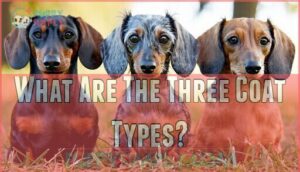This site is supported by our readers. We may earn a commission, at no cost to you, if you purchase through links.
 You might think you know dachshunds, but these "sausage dogs" hide surprising secrets.
You might think you know dachshunds, but these "sausage dogs" hide surprising secrets.
They were Germany’s badger hunters, built long and low to chase prey underground. Queen Victoria owned one, making them royal favorites.
Here’s a wild fact: a dachshund named Waldi became the first-ever Olympic mascot in 1972. These pups come in three coat types and dozens of color combinations you’ve probably never seen.
They’re natural diggers who’ll turn your yard into Swiss cheese. Many smell like corn chips due to natural bacteria on their paws.
Their loyalty runs deeper than their short legs suggest, creating bonds that’ll melt your heart. They are also known for being natural diggers.
Table Of Contents
- Key Takeaways
- What is a Dachshund?
- How Many Colors and Markings?
- What Are The Different Sizes?
- What Are The Three Coat Types?
- How Long is Their Lifespan?
- Are They Prone to Obesity?
- What Are Tweenies?
- Common Behaviors
- Interesting Trivia
- Frequently Asked Questions (FAQs)
- How much exercise does a Dachshund need?
- Are Dachshunds good with children?
- How much space does a Dachshund need?
- Are Dachshunds easy to train?
- What is the best way to groom a Dachshund?
- Can Dachshunds swim with their short legs?
- Why do Dachshunds have such long ears?
- What makes Dachshunds so vocal and talkative?
- Do Dachshunds really need back support ramps?
- Why are Dachshunds called wiener dogs?
- Conclusion
Key Takeaways
- You’ll discover that Waldi the Dachshund made history as the first-ever Olympic mascot in 1972, representing athletic qualities like resistance and tenacity that organizers admired in the breed.
- Your Dachshund’s corn chip-scented paws aren’t unusual – they’re caused by harmless bacteria called Pseudomonas and Proteus that naturally live between their toe pads in warm, moist spaces.
- You’re looking at three distinct coat types that actually influence personality – smooth coats require minimal grooming, wirehaired coats bring terrier-like spunk, and longhaired varieties tend to be gentler but need daily brushing.
- Your wiener dog’s digging obsession stems from their 17th-century German breeding as badger hunters who needed to chase prey underground, making backyard excavation an unstoppable genetic instinct.
What is a Dachshund?
Ever wondered what makes a Dachshund tick? These adorable "sausage dogs" aren’t just cute—they’re hardworking scent hounds with serious German origins.
Originally bred for badger hunting in 17th-century Germany, Doxies earned their name from "dachs" (badger) and "hund" (dog).
These determined little hunters were literally built to chase badgers into their own underground lairs.
Their unique body structure—long torso, short legs, and muscular build—was specifically designed for tracking prey underground.
This breed history explains why your Doxen still loves digging in your backyard. They’re natural-born hunters disguised as lap dogs, with a history that highlights their ability to track prey, making them a fascinating example of serious German origins.
How Many Colors and Markings?
Dachshunds are like a box of crayons – you’ll find an amazing rainbow of possibilities! These "sausage dogs" come in six base colors including red, cream, black and tan, and chocolate variations.
But here’s where it gets interesting: color genetics create even more stunning combinations.
Here are three fascinating doxen color patterns you mightn’t know about:
- Dapple variations create beautiful marbled effects that look like watercolor paintings
- Piebald dachshunds sport white patches with colored spots that can change dramatically as they age
- Brindle patterns add tiger-like stripes over the base coat colors
Don’t forget about dilute colors – these special genes turn black into blue and chocolate into isabella (fawn). Your puppy’s coat colors and markings will likely change as they grow up. That adorable piebald might develop "ticking" – small colored spots appearing over white areas. It’s like watching your dog’s personality develop through their coat!
What Are The Different Sizes?
Beyond their rainbow of colors, these sausage dogs come in distinct sizes that’ll surprise you. You might think there are just two, but there’s actually more to the story.
Standard Size dachshunds tip the scales at 16-32 pounds, while Miniature Size pups weigh up to 11 pounds. But here’s where it gets interesting – there’s also the Kaninchen Size, recognized internationally but not in the US. These "rabbit hunters" are even smaller than miniatures.
| Size Type | Weight Limits | Purpose | Recognition |
|---|---|---|---|
| Standard Doxen | 16-32 lbs | Badger hunting | AKC recognized |
| Miniature Doxen | Up to 11 lbs | Rabbit hunting | AKC recognized |
| Kaninchen | Varies by region | Small game | FCI only |
| Tweenies | 12-15 lbs | Inbetween size | Unofficial |
Tweenies fall between standard and miniature – they’re the middle children nobody talks about! Size Variations depend purely on weight at one year old, not length.
What Are The Three Coat Types?
Your dachshund’s coat isn’t just about looks—it’s about personality too. These wiener dogs come in three distinct coat types, each with its own charm and grooming needs.
Smooth coats are the classic choice. They’re sleek, shiny, and require minimal fuss. A quick brush once a week keeps your smoothhaired doxen looking sharp.
Wirehaired coats bring that scruffy, distinguished look with coarse, wiry hair that needs regular brushing to prevent matting. Longhaired coats are the glamorous ones—silky, flowing, and absolutely gorgeous, but they demand daily brushing to maintain their beauty.
Here’s something cool: coat genetics determine more than texture. Longhaired doxen tend to be gentler, while wirehaired doxen often show more terrier-like spunk. Each coat type showcases different doxen colors patterns beautifully, from deep chocolates to dappled silvers. Choose based on your grooming commitment and lifestyle preferences.
How Long is Their Lifespan?
Your furry friend’s got staying power! Most doxen dachshunds live 12-16 years, with some record lifespans reaching their early twenties.
These impressive numbers put them ahead of many larger breeds in terms of dog longevity.
Several factors influence your dachshund lifespan:
- Genetic factors from responsible breeding practices
- Preventative care including regular vet checkups and vaccinations
- Lifestyle impact from proper diet and exercise routines
This breed longevity means you’ll have plenty of years together, though proper care makes all the difference in maximizing their lifespan.
Mixed breeds often exhibit hybrid vigor benefits, potentially extending their lives.
Are They Prone to Obesity?
Yes, your wiener dog can easily pack on pounds! These low-riding pups face higher obesity risks due to their unique build and love for food.
Their short legs make vigorous exercise challenging, while their "food-first" mentality doesn’t help. Proper weight management requires strict portion control and consistent exercise regimens adapted to their needs.
Skip high-calorie treats and focus on healthy treat alternatives. Understanding your doxen dachshund’s dietary needs prevents serious health issues like diabetes and spinal problems that plague overweight dogs.
It’s also helpful to understand the body condition scoring to accurately assess your dog’s weight.
What Are Tweenies?
You’ve probably heard of miniature and standard Dachshunds, but what about tweenies? These Doxen fall perfectly between official sizes, weighing 12-15 pounds.
While breed standards don’t recognize this uncommon size category, tweenie Dachshunds have gained popularity among owners who want something bigger than a mini but smaller than a standard.
They’re like the Goldilocks of wiener dogs—just right! Though they won’t qualify for show eligibility in traditional size classes, wonderful family pets with their perfect middle-ground proportions.
Common Behaviors
You’ll notice your Dachshund has some quirky habits that come straight from their badger-hunting past.
These behaviors might seem odd at first, but they’re actually normal parts of what makes your wiener dog tick.
On Leash
Walking your Dachshund on leash can feel like walking a furry tornado with opinions. These vocal pups often display leash reactivity, barking at everything from squirrels to mailboxes.
Safe harnesses work better than collars since they protect those vulnerable necks and spines. Leash training starts with patience – your Doxie’s nose leads the expedition, not you.
Their hunting instincts kick in fast, so recall training becomes your best friend when they spot something interesting. Walking etiquette means short, frequent walks rather than marathons.
Watch for leash aggression around other dogs. Proper dog socialization from puppyhood helps, but some Dachshunds stay suspicious of strangers. Consider using a dachshund-safe harness option for added security.
Remember, you’re not just walking a dog – you’re chaperoning a tiny detective on four legs.
Digging
Most Dachshunds turn into tiny excavators the moment they step outside. This instinctual digging stems from their breed history as badger hunters who needed to create burrows and chase prey underground. Don’t be surprised if your wiener dog treats your flower beds like personal construction sites.
Your Dachshund’s digging instinct runs deep, but you can manage it without losing your sanity or your landscaping.
- Create designated digging zones – Set up a sandbox or specific yard area where digging’s allowed
- Provide digging alternatives – Hide treats in snuffle mats or puzzle toys for indoor activities
- Increase exercise – Tired dogs dig less, so daily walks help reduce yard damage
- Redirect the behavior – When you catch them digging, immediately guide them to appropriate burrowing activities
Remember, fighting their natural instincts is like swimming upstream. Instead, work with their DNA and channel that energy into acceptable outlets. Similarly, some breeds, like huskies, may dig due to boredom and anxiety.
Sleeping
Little sausage-shaped sleepyheads have fascinating nighttime habits that’ll surprise you.
Your Dachshund’s sleeping patterns reveal their wild ancestry – they love burrowing under blankets because badger-hunting required cozy den skills.
These pups sleep 12-14 hours daily, with puppies needing even more rest for proper development.
You’ll notice interesting sleep positions: curled tight like furry donuts or stretched out claiming maximum bed space.
Dream activity shows through twitching paws and soft barks – they’re probably chasing imaginary squirrels!
Bed sharing becomes inevitable since Doxens crave warmth and companionship.
Their sleeping habits include multiple naps throughout the day, especially after meals or playtime.
Owners often search for cozy dachshund bedding to enhance their comfort.
Understanding these dog behavior patterns helps you recognize when something’s off with your pup’s health or comfort levels.
This knowledge is crucial for providing the best care for your Dachshund, ensuring they have a happy and healthy life.
Loyalty
Your Doxen’s bonding strength runs deeper than most breeds realize.
Your wiener dog doesn’t just love you—they’d follow you to the ends of the earth and back again.
These family companions form unshakeable owner devotion, often shadowing you room to room like furry bodyguards.
Their protective instincts kick in when strangers approach, leading to vocal warnings that announce "my human!"
Dachshunds’ loyalty traits can trigger separation anxiety when left alone.
This dog personality craves constant companionship, making them devoted but sometimes clingy partners who’d follow you anywhere, driven by their strong bonding and unshakeable owner devotion.
Interesting Trivia
You probably know dachshunds as wiener dogs, but these sausage-shaped pups have some wild stories that’ll surprise you.
From royal connections to Olympic fame, your favorite hot dog look-alike has made quite the mark on history.
Queen Victoria
You might think royal dogs live pampered lives, but Queen Victoria’s love affair with Dachshunds changed history forever.
Her Royal Influence during the Victorian Era transformed these German hunting dogs into Britain’s beloved companions. The queen didn’t just own Doxen – she made them fashionable across the empire.
Queen Victoria’s passion for Dachshunds created a ripple effect that boosted British Popularity and established lasting Breed Recognition.
Here’s how her Lasting Legacy unfolded:
- Royal endorsement – Her public affection legitimized the breed among British aristocracy
- Social trendsetting – Noble families rushed to adopt Dachshunds following her example
- Cultural integration – The dogs became symbols of refined taste in Victorian society
- International expansion – British influence spread Dachshund appreciation worldwide
This Dog History moment proves that even queens can’t resist those adorable sausage-shaped pups.
Victoria’s devotion helped secure Dachshund History as more than just hunting dogs.
The First Olympic Mascot
Here’s history you didn’t know: Waldi the Dachshund became the first-ever Olympic mascot at the 1972 Munich Games.
This colorful, striped pup wasn’t chosen randomly. Olympic organizers picked Dachshunds because they represented key athletic qualities – resistance, tenacity, and agility.
Waldi’s legacy sparked the mascot selection tradition we see today, with each Olympics featuring unique characters.
This breed popularity boost from Olympic symbolism helped cement Dachshunds as beloved worldwide companions through design evolution.
WWII Propaganda
World War II brought unexpected challenges for dachshunds in America.
These German dogs suddenly found themselves caught in a web of anti-German sentiment and wartime symbolism.
You’d be surprised how propaganda transformed these lovable sausage dogs into symbols of the enemy.
The American Kennel Club tried to distance the breed from its German roots through creative breed renaming:
- Liberty Pups – An attempt to rebrand dachshunds as patriotic American dogs
- Badger Dogs – Using their original hunting purpose to avoid German associations
- Temporary name changes – These efforts lasted briefly but didn’t stick long-term
WWII propaganda often featured dachshunds as representations of Germany, with posters showing them being chased or attacked by bulldogs representing America.
Despite this negative portrayal, many dachshunds actually served bravely in the war, including mine detection dogs who saved countless lives in Europe.
Corn Chip Smell
Ever noticed your Doxen’s paws smell like Fritos? You’re not imagining things! This corn chip smell, often called "Frito feet," affects many Dachshunds and other breeds.
The culprit isn’t anything mysterious – it’s simply Bacteria Culprits living naturally on your dog’s paws. Two types of Pawsitive Fungi, Pseudomonas and Proteus, create this distinctive scent.
These harmless microorganisms thrive in warm, moist spaces between toe pads. While Breed Specificity isn’t proven, many Dachshund owners report this phenomenon more frequently than other breeds.
Consider using convenient paw cleaning products to maintain paw hygiene. Your Owner Perception might worry about cleanliness, but this odor doesn’t indicate poor Hygiene Impact.
Regular paw washing helps minimize the smell, though it’s completely normal. These quirky dog facts remind us that our beloved Doxen companions come with their own unique aromatic signatures – making them even more endearingly special.
Frequently Asked Questions (FAQs)
How much exercise does a Dachshund need?
Your Dachshund needs about 30-60 minutes of daily exercise, but don’t overdo it.
Short walks and indoor play work best.
Their long backs aren’t built for marathons, so keep activities moderate and fun.
Are Dachshunds good with children?
With proper socialization, they’re great family pets.
Their playful nature entertains kids, but you’ll need to teach children gentle handling since Dachshunds have sensitive backs that can be injured by rough play.
How much space does a Dachshund need?
Despite weighing just 11-32 pounds, you’ll find your Dachshund adapts wonderfully to apartments or houses.
They need moderate daily exercise but don’t require massive yards.
A cozy living space works perfectly for these compact companions.
Are Dachshunds easy to train?
Training your Dachshund requires patience and consistency since they’re independent thinkers bred for hunting.
They’re smart but stubborn, so use treats and positive reinforcement.
Don’t expect instant obedience—they’ll test your limits!
What is the best way to groom a Dachshund?
Like polishing a cherished family heirloom, you’ll want to brush your dachshund’s coat weekly with appropriate tools.
Smooth coats need minimal care, while longhaired varieties require daily brushing to prevent matting and tangles.
Can Dachshunds swim with their short legs?
Yes, your Dachshund can swim! Their short legs don’t stop them from paddling effectively.
Many Doxies enjoy water activities.
Start with shallow water and supervise closely. Consider a doggy life jacket for extra safety and confidence.
Why do Dachshunds have such long ears?
Your Dachshund’s long ears aren’t just for show—they’re scent-catching machines.
Those floppy ears sweep up smells from the ground and funnel them to their nose, helping them track prey like badgers and rabbits.
What makes Dachshunds so vocal and talkative?
Your wiener dog’s a four-legged chatterbox because they’re bred hunters with strong opinions.
Dachshunds use barking to communicate during hunts, alert you to visitors, and express their independent personalities.
They’re naturally vocal conversationalists.
Do Dachshunds really need back support ramps?
Back support ramps aren’t absolutely necessary for every Dachshund, but they’re smart prevention. Your pup’s long spine handles stress better with gradual inclines than sudden jumps from couches or beds.
Why are Dachshunds called wiener dogs?
You’ve probably noticed the resemblance yourself – their long, cylindrical bodies and short legs look exactly like hot dogs.
This amusing similarity earned them the beloved nickname "wiener dogs" alongside their formal German name.
Conclusion
Like treasures hidden in plain sight, these facts you didn’t know about doxen dachshunds reveal there’s more to your wiener dog than meets the eye.
From Olympic fame to royal connections, these long-bodied companions pack surprising history into their compact frames.
Whether they’re digging up your garden or smelling like corn chips, dachshunds continue to charm owners worldwide.
You’ll never look at your sausage dog the same way again after discovering these delightful secrets.













